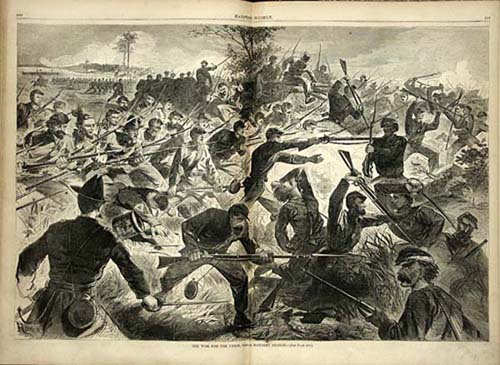For millennia, soldiers had terrified their foes with shar/edged stone & metal blades, lined endlessly in rank after rank before an attack in the promise of painful bloody battle. Although the Civil War brought with it the use of small arms, edged weapons still played a primary role in the fighting that ensued.
Bayonets
During the Civil War nearly 2 million men carried bayonets of varying sizes and descriptions. The variety was almost bewildering. The average bayonet was 18” in length with a triangular cross section and tapering to a sharp point, with deep grooves between its edges. Some, of course, were shorter, little more than camp knives, while others stretched beyond the norm extending nearly 2 feet beyond the muzzle of a rifle. The longer ones like the saber bayonet used with the British Pattern 1853 short rifle (600236) were literally swords making them incredibly lethal in long range and short range combat, but cumbersome to carry and wield in hand-to-hand fighting. Of course, when not in battle the bayonet made a handy tent stake, candle holder, and was even known to be used to grind coffee beans.

Wood Engraving for Harper''s Weekly, July 12, 1862
Sabers
The great majority of swords in use by both armies was based upon or were, standard patterns issued by the old US army and these were in turn copies of British and French models from before the war.
The model 1840 and 1860 (500618) cavalry sabers were predominant among Union horse brigades and a great many Confederates carried them as well (after picking them up from the battlefield). Dozens of patterns were manufactured by Confederate makers, but the basic designs between the two sides differed very little. Officers on both sides for instance carried the model 1840 (500350) or the lighter model 1841 light artillery saber. It should be noted that many commanders, especially from the Confederacy, brought their own blades from home.
Some artillery batteries equipped their cannoneers with weapons like the Roman gladius looking model 1833 foot artillery short sword. Since the cannoneers rarely saw battle close-up and the sword was so heavy for its size, it was discarded by most as little more than a nuisance.
It should be noted it was the cavalry that used their sabers with efficiency more than any others carrying swords (500050, 500188). The wicked lightning quick strikes of the horse charge was nearly impossible to stand against when firearms, then swords were brought into play. The reach and momentum made any strike ferocious. You got out of the way of a charging war horse and skilled swordsman or you didn’t see the dawn of a new day.
Although the infantry carried swords, these were used primarily to advance the ranks and rally them as opposed to close quarters combat.
The navy also carried swords, but a cutlass was the chosen model. The model 1841 or 1860 (500152) pattern was used the most and still today exudes the traits that were associated with pirates and their chosen blades. Storming a deck was a nasty affair and the tight confines needed an appropriate and effective chopping weapon.
Knives
It is the Bowie knife that was prized the most by the infantry. Some of these combat knives, especially the Confederate “D” guard Bowie (400928) reached almost short sword lengths. A great variety of sheath knives, as well as small clasp knives were carried and used in camp life as much if not more than they ever were used in combat, but all soldiers on both sides carried some sort of knife at all times.


 Gift Cards
Gift Cards